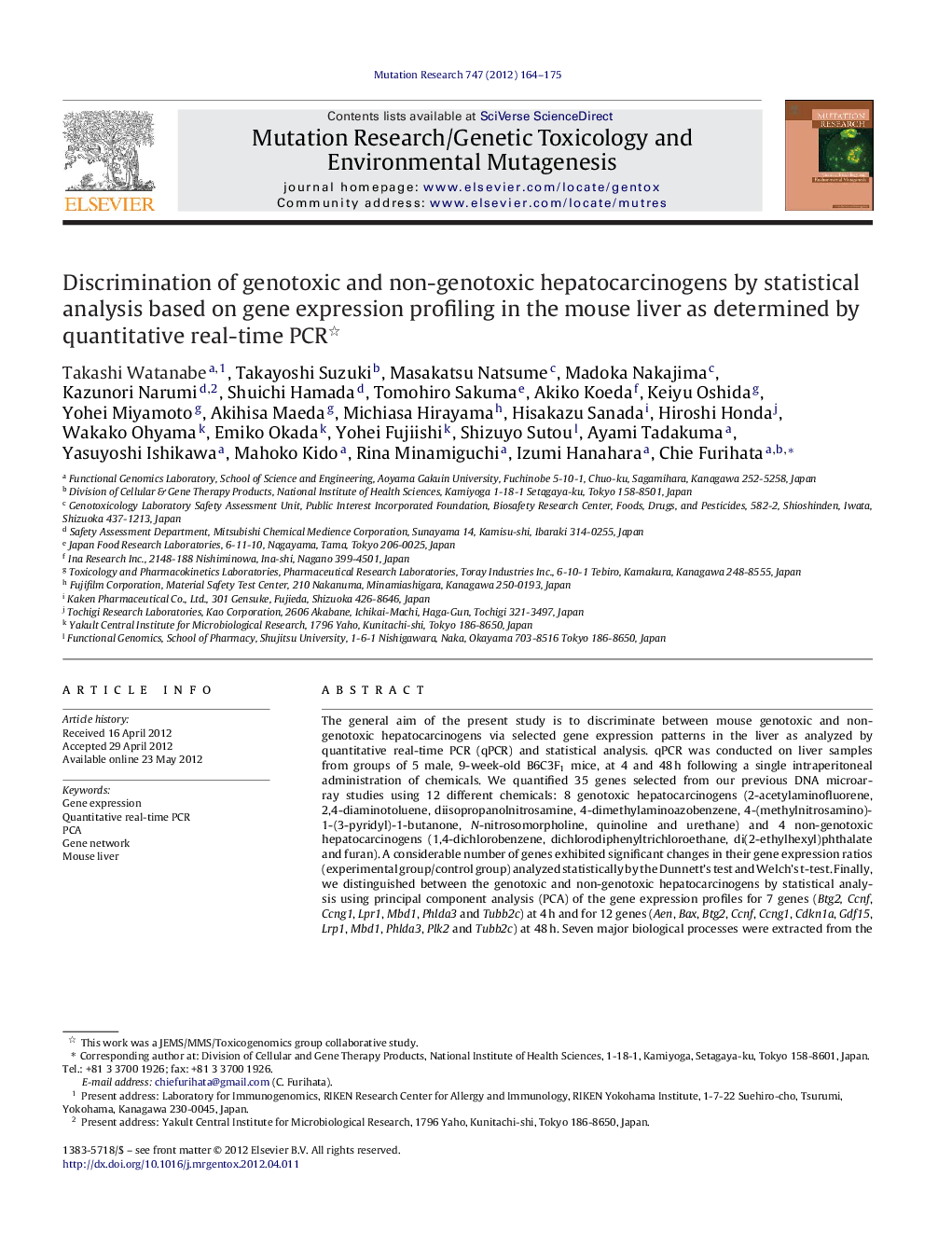| کد مقاله | کد نشریه | سال انتشار | مقاله انگلیسی | نسخه تمام متن |
|---|---|---|---|---|
| 2148206 | 1089544 | 2012 | 12 صفحه PDF | دانلود رایگان |

The general aim of the present study is to discriminate between mouse genotoxic and non-genotoxic hepatocarcinogens via selected gene expression patterns in the liver as analyzed by quantitative real-time PCR (qPCR) and statistical analysis. qPCR was conducted on liver samples from groups of 5 male, 9-week-old B6C3F1 mice, at 4 and 48 h following a single intraperitoneal administration of chemicals. We quantified 35 genes selected from our previous DNA microarray studies using 12 different chemicals: 8 genotoxic hepatocarcinogens (2-acetylaminofluorene, 2,4-diaminotoluene, diisopropanolnitrosamine, 4-dimethylaminoazobenzene, 4-(methylnitrosamino)-1-(3-pyridyl)-1-butanone, N-nitrosomorpholine, quinoline and urethane) and 4 non-genotoxic hepatocarcinogens (1,4-dichlorobenzene, dichlorodiphenyltrichloroethane, di(2-ethylhexyl)phthalate and furan). A considerable number of genes exhibited significant changes in their gene expression ratios (experimental group/control group) analyzed statistically by the Dunnett's test and Welch's t-test. Finally, we distinguished between the genotoxic and non-genotoxic hepatocarcinogens by statistical analysis using principal component analysis (PCA) of the gene expression profiles for 7 genes (Btg2, Ccnf, Ccng1, Lpr1, Mbd1, Phlda3 and Tubb2c) at 4 h and for 12 genes (Aen, Bax, Btg2, Ccnf, Ccng1, Cdkn1a, Gdf15, Lrp1, Mbd1, Phlda3, Plk2 and Tubb2c) at 48 h. Seven major biological processes were extracted from the gene ontology analysis: apoptosis, the cell cycle, cell proliferation, DNA damage, DNA repair, oncogenes and tumor suppression. The major, biologically relevant gene pathway suggested was the DNA damage response pathway, resulting from signal transduction by a p53-class mediator leading to the induction of apoptosis. Eight genes (Aen, Bax, Btg2, Ccng1, Cdkn1a, Gdf15, Phlda3 and Plk2) that are directly associated with Trp53 contributed to the PCA. The current findings demonstrate a successful discrimination between genotoxic and non-genotoxic hepatocarcinogens, using qPCR and PCA, on 12 genes associated with a Trp53-mediated signaling pathway for DNA damage response at 4 and 48 h after a single administration of chemicals.
► We quantified gene expression in mouse liver by quantitative real-time PCR.
► We quantified 35 genes selected from our previous DNA microarray studies.
► We compared 8 genotoxic and 4 non-genotoxic hepatocarcinogens in mouse liver.
► We discriminated 2 types of hepatocarcinogens by statistical analysis using PCA.
► We discriminated 2 types of hepatocarcinogens by principal component analysis.
Journal: Mutation Research/Genetic Toxicology and Environmental Mutagenesis - Volume 747, Issue 2, 18 September 2012, Pages 164–175